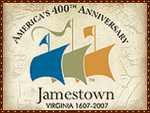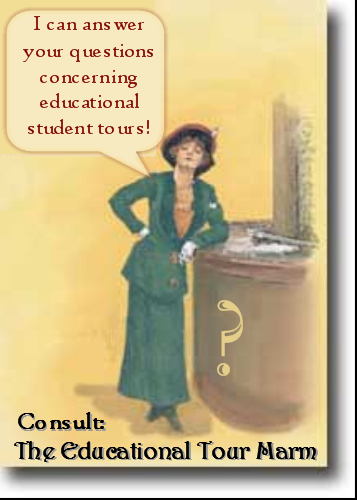Did you hear the one about the Polish strike in Jamestown?



Figure It Out Friday 06/22/07
Waiting for a punchline? Read on.
If you look at my archives on the side of this page, you will notice that there aren't any entries for May. May was a particularly busy month for me as I was on tour for all but one day!
On my one day off, May 12th, I went on a busman's holiday and visited Jamestown on the anniversary weekend with my brother/cousin and stepmother/cousin. My stepmother had visited Jamestown in 1957 and her father, my cousin as well, had visited in 1907! So it's a bit of a family tradition and important for us to pay respects to our ancestors who settled in Jamestown.
We were more interested in Jamestown Island that day and attended lectures, watched demonstrations, and my stepmother and brother were particularly engrossed in the excavations and the new museum of archeology called the Archaearium
While we were on the top of the mound opposite the church listening to the findings of the archaeologists, I noticed a color guard carrying an American flag as well as a Polish one, marching briskly past the ruins of the old church
I remembered that for years the National Park Service had leaflets printed in Polish at their visitors' center because Jamestown was also a Polish shrine.
Knowing that I have a bit of Polish somewhere in my mosaic background (through my maternal grandfather), I deserted my British-based relatives and proceeded to follow the Polish guard until they stopped in front of the statue of John Smith overlooking the James River.
These were members of The Polish Pioneers of Jamestown.
The Poles in Jamestown
On October 1, 1608, the Mary and Margaret, the first supply ship to Jamestown after the founding of the colony, carried 5 Poles and Pomeranian Germans (referred to as 'Dutchmen') who were hired by the London Company at the suggestion of either Captain John Smith or Captain Christopher Newport. (John Smith took the credit.)
Smith knew the worth of the Poles after spending a few years in Poland and having fought beside them against the Turks in Hungary. The Poles were known to be fierce, capable, resourceful, great tradesmen, and superb craftsmen and artisans; they had a near monopoly on glass and the naval trades. Newport had traded extensively with the Poles.
These men were expected to develop the first export industry in British America, glass, as well as utilize their skills in pitchmaking, potash, timber (for shipbuilding), and military training to bolster the struggling colony.
When the Jamestown Settlers were having problems getting fresh water, it was the Poles who dug the first wells to help alleviate the problem and bring the first reliable source of safe drinking water.
John Smith was extremely pleased with these industrious workman, and requested that more Poles be sent. More did come with their families.
In 1619, Governor Sir George Yeardley issued a call for an Assembly meeting to set up the first representative legislative assembly in the new world. By charter and decree, only the British Virginians were allowed to vote. The Poles, being foreign born and many, Roman Catholic, were excluded.
After having endured years of hardship and labor in helping to sustain the settlement, the Polish Virginians felt insulted. 'No vote, no work' was their defiant rallying cry! Michal Lowicki, Zbigniew Stefanski, Jan Nata, Jan Brogdan, Karol Zrenica, and Stanislas Sadowski led the strike.
Their value and contributions to the colony and the effect it would have on the export industry persuaded the Virginia Company to include them, overturning the vote of the House of Burgesses; thus the Polish and German families became fully franchised into the colony.
Through this work-stoppage in 1619, the Poles became the first in America to strike to gain their civil rights, 361 years before Lech Walesa's Solidarity strike in Gdansk (for which he received the Nobel Peace Prize in 1983).
October 1st will mark the 400th anniversary of the Polish presence at Jamestown and the descendants of the original Polish settlers, The Polish Pioneers in Jamestown will be there just as they were on May 12th (pictured above) as well as Poles from all over the nation. However, you don't have to be Polish to attend, all are invited!)
The Polish inclusion in the all-British colony was America's epiphany for future immigration and civil rights.
And that's no joke.
----------------------------------------------------------------------------------------------
Touring with Students:
Most student tour groups visit Jamestown Settlement which exhibits a re-creation of the fort, three ships, Chickahominy village, and splendid museum. Perhaps they might visit the glassblowing house. So many groups never venture beyond the glassblowing house onto the original site of Jamestown. That is the most fascinating part! The National Park Service and The Association for the Preservation of Virginia Antiquities (APVA) have maintained the site in an almost pristine setting. One can see the original foundations of the later settlement, the ruins of the church (the site of the beginnings of democracy in the new world), historic cemetery, excavations, and the new Archaearium (archeological museum). The Park Service has a fantastic new visitors' center which includes a museum and film. One can get curriculum-based tours and activities through both the NPS and APVA.
School groups need to have a fee-waiver letter to get in free, all others have to pay the National Park entrance fees, unless one has a National Park Pass.
Interesting Websites:
Jamestown Island National Park Service
Jamestown Rediscovery - APVA
Polish Pioneers in Jamestown
Polish American Anniversary Celebration Committee
Courtly Lives
Historic Jamestown
NPS Archeology















No comments:
Post a Comment